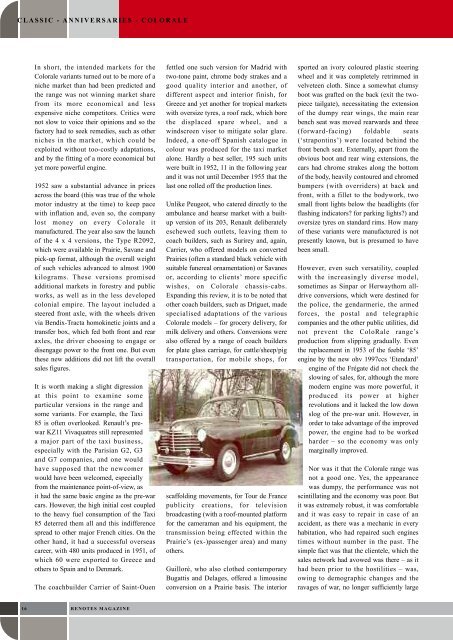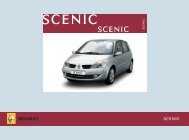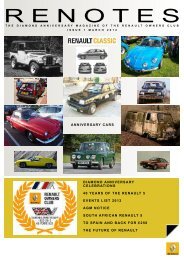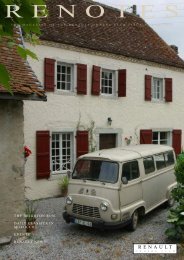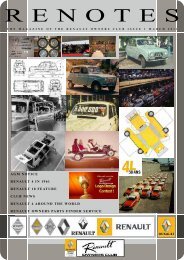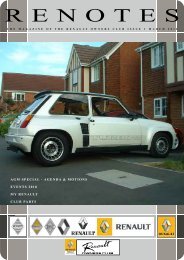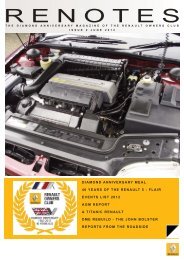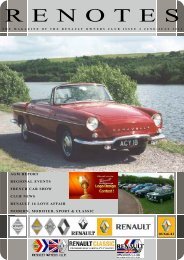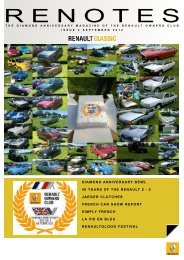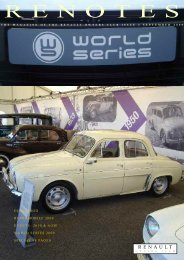September 2010 44 Pages Draft.pdf - Renault Owners Club Forum
September 2010 44 Pages Draft.pdf - Renault Owners Club Forum
September 2010 44 Pages Draft.pdf - Renault Owners Club Forum
Create successful ePaper yourself
Turn your PDF publications into a flip-book with our unique Google optimized e-Paper software.
C L A s s I C - A N N I V E R s A R I E s - C o L o R A L EIn short, the intended markets for theColorale variants turned out to be more of aniche market than had been predicted andthe range was not winning market sharefrom its more economical and lessexpensive niche competitors. Critics werenot slow to voice their opinions and so thefactory had to seek remedies, such as otherniches in the market, which could beexploited without too-costly adaptations,and by the fitting of a more economical butyet more powerful engine.1952 saw a substantial advance in pricesacross the board (this was true of the wholemotor industry at the time) to keep pacewith inflation and, even so, the companylost money on every Colorale itmanufactured. The year also saw the launchof the 4 x 4 versions, the Type R2092,which were available in Prairie, Savane andpick-up format, although the overall weightof such vehicles advanced to almost 1900kilograms. These versions promisedadditional markets in forestry and publicworks, as well as in the less developedcolonial empire. The layout included asteered front axle, with the wheels drivenvia Bendix-Tracta homokinetic joints and atransfer box, which fed both front and rearaxles, the driver choosing to engage ordisengage power to the front one. But eventhese new additions did not lift the overallsales figures.It is worth making a slight digressionat this point to examine someparticular versions in the range andsome variants. For example, the Taxi85 is often overlooked. <strong>Renault</strong>’s prewarKZ11 Vivaquatres still representeda major part of the taxi business,especially with the Parisian G2, G3and G7 companies, and one wouldhave supposed that the newcomerwould have been welcomed, especiallyfrom the maintenance point-of-view, asit had the same basic engine as the pre-warcars. However, the high initial cost coupledto the heavy fuel consumption of the Taxi85 deterred them all and this indifferencespread to other major French cities. On theother hand, it had a successful overseascareer, with 480 units produced in 1951, ofwhich 60 were exported to Greece andothers to Spain and to Denmark.The coachbuilder Carrier of Saint-Ouenfettled one such version for Madrid withtwo-tone paint, chrome body strakes and agood quality interior and another, ofdifferent aspect and interior finish, forGreece and yet another for tropical marketswith oversize tyres, a roof rack, which borethe displaced spare wheel, and awindscreen visor to mitigate solar glare.Indeed, a one-off Spanish catalogue incolour was produced for the taxi marketalone. Hardly a best seller, 195 such unitswere built in 1952, 11 in the following yearand it was not until December 1955 that thelast one rolled off the production lines.Unlike Peugeot, who catered directly to theambulance and hearse market with a builtupversion of its 203, <strong>Renault</strong> deliberatelyeschewed such outlets, leaving them tocoach builders, such as Surirey and, again,Carrier, who offered models on convertedPrairies (often a standard black vehicle withsuitable funereal ornamentation) or Savanesor, according to clients’ more specificwishes, on Colorale chassis-cabs.Expanding this review, it is to be noted thatother coach builders, such as Driguet, madespecialised adaptations of the variousColorale models – for grocery delivery, formilk delivery and others. Conversions werealso offered by a range of coach buildersfor plate glass carriage, for cattle/sheep/pigtransportation, for mobile shops, forscaffolding movements, for Tour de Francepublicity creations, for televisionbroadcasting (with a roof-mounted platformfor the cameraman and his equipment, thetransmission being effected within thePrairie’s (ex-)passenger area) and manyothers.Guilloré, who also clothed contemporaryBugattis and Delages, offered a limousineconversion on a Prairie basis. The interiorsported an ivory coloured plastic steeringwheel and it was completely retrimmed invelveteen cloth. Since a somewhat clumsyboot was grafted on the back (exit the twopiecetailgate), necessitating the extensionof the dumpy rear wings, the main rearbench seat was moved rearwards and three(forward-facing) foldable seats(‘strapontins’) were located behind thefront bench seat. Externally, apart from theobvious boot and rear wing extensions, thecars had chrome strakes along the bottomof the body, heavily contoured and chromedbumpers (with overriders) at back andfront, with a fillet to the bodywork, twosmall front lights below the headlights (forflashing indicators? for parking lights?) andoversize tyres on standard rims. How manyof these variants were manufactured is notpresently known, but is presumed to havebeen small.However, even such versatility, coupledwith the increasingly diverse model,sometimes as Sinpar or Herwaythorn alldriveconversions, which were destined forthe police, the gendarmerie, the armedforces, the postal and telegraphiccompanies and the other public utilities, didnot prevent the ColoRale range’sproduction from slipping gradually. Eventhe replacement in 1953 of the feeble ‘85’engine by the new ohv 1997ccs ‘Etendard’engine of the Frégate did not check theslowing of sales, for, although the moremodern engine was more powerful, itproduced its power at higherrevolutions and it lacked the low downslog of the pre-war unit. However, inorder to take advantage of the improvedpower, the engine had to be workedharder – so the economy was onlymarginally improved.Nor was it that the Colorale range wasnot a good one. Yes, the appearancewas dumpy, the performance was notscintillating and the economy was poor. Butit was extremely robust, it was comfortableand it was easy to repair in case of anaccident, as there was a mechanic in everyhabitation, who had repaired such enginestimes without number in the past. Thesimple fact was that the clientele, which thesales network had avowed was there – as ithad been prior to the hostilities – was,owing to demographic changes and theravages of war, no longer sufficiently large16 R E N o T E s m A G A Z I N ER E N O T E S M A G A Z I N E


